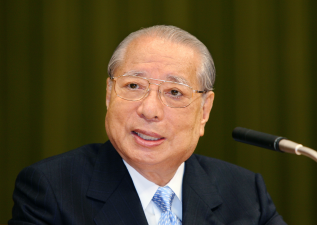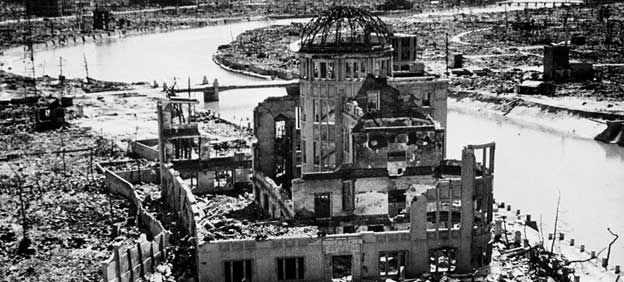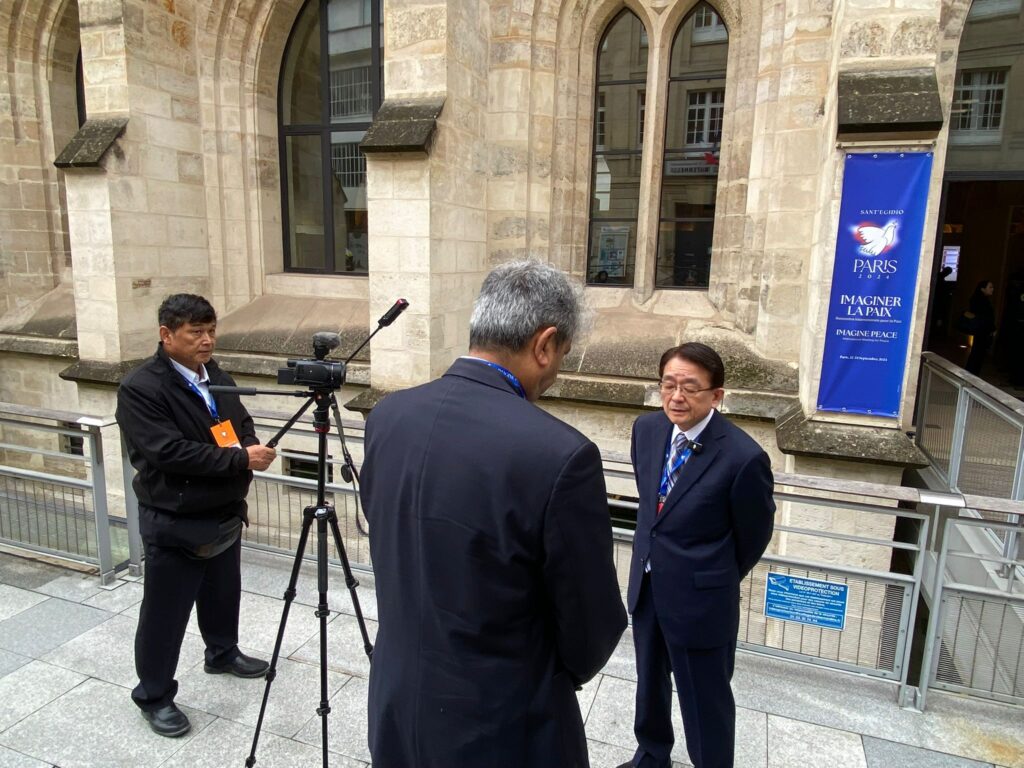【Paris/Tokyo INPS Japan=Correspondents】
Q: How do you think the Paris Peace Forum contributes to a broader international dialogue on nuclear disarmament?
Terasaki: This conference was hosted by the Catholic organization the Community of Sant’Egidio, which is headquartered in Rome. Every year, they hold a large-scale international interfaith conference like this, providing a space for dialogue and the sharing of perspectives and insights on the challenges faced by diverse modern societies. We are very grateful for the opportunity to participate in this conference as SGI, especially in a forum focused on nuclear disarmament. The issue of nuclear weapons, needless to say, is one of the most critical challenges in today’s society. Creating an opportunity to share our awareness of these issues with representatives of religious communities from around the world is a significant and rewarding challenge for us.
Q: As an SGI representative, what unique perspectives of philosophies do you bring to this question of global peace and security?
Terasaki: Our peace movement, particularly our efforts toward a world without nuclear weapons, originates from the Declaration Calling for the Abolition of Nuclear Weapons made by Josei Toda, the second president of the Soka Gakkai, in September 1957. At that time, there was deep concern about the proliferation of nuclear weapons due to the competitive nuclear testing. President Toda’s key message to the youth gathered at that time, which he wanted to pass on as his legacy, was that this is a battle to protect humanity’s right to survival. From this perspective, while physically eliminating nuclear weapons is the primary goal, the more profound issue is the reality that humanity, in its pursuit of war, even with nuclear weapons, threatens this right to survival. Thus, our movement is not only a concrete effort toward nuclear disarmament but also a broader initiative to safeguard humanity’s fundamental right to exist.

In this sense, our approach to nuclear disarmament and abolition is twofold. First, from the perspective of humanity’s right to survive, we have long focused on highlighting the humanitarian issues and the stark reality of nuclear exposure to raise awareness about the consequences of using nuclear weapons. Second, as expressed by President Daisaku Ikeda, who succeeded President Toda, the essence of the nuclear issue lies in the mentality that justifies possessing such indiscriminate weapons of mass destruction solely to fulfill the desire for domination. This ‘struggle against the mindset of possessing nuclear weapons’ is a perspective we have clearly defined, and I believe it is a distinguishing feature of our movement.
Q: What concrete steps do you believe it can take right now to accelerate nuclear disarmament especially with impending gopolitical tensions?
Terasaki: I believe we are in an extremely challenging and critical situation. Many people are feeling a sense of hopelessness or helplessness in this current climate, which could potentially amplify discrimination. The theme of this conference, ‘Imagine Peace,’ emphasizes precisely this — the need to ‘envision peace.’ I believe this is the most important theme for us right now.
While it’s certainly important to learn lessons from how we have addressed issues in the past, what’s even more crucial is how much all of humanity is concentrating on new ideas and new challenges. In that sense, I believe that the fight against pessimism and indifference is precisely the hurdle we must first overcome in the current crisis.
In civil society, we must explore every possibility and every challenge, sharing a sense of crisis and raising our voices together in unprecedented solidarity. In doing so, we can create a significant breakthrough and influence decision-makers. It is essential that young people are not passive but stand alongside us in overcoming the challenges of this era. This is the kind of solidarity we should aim for. In this regard, conferences like this one are extremely important, which is why we are participating.
Q: You are a strong advocate for the “No First Use” policy. Could you elaborate on why this policy is crucial for global nuclear disarmament?
Terasaki: Certainly, this discussion was present in the 20th century as well. At that time, some criticized it as merely giving nuclear-armed states more time and argued that it would not lead to genuine nuclear disarmament. We are well aware of these criticisms.”
However, the crisis we face now is far more severe than anything we have seen before. We are witnessing an unprecedented situation where nuclear-armed states, which once upheld the NPT framework, are now directly involved in conflicts. This makes an immediate shift toward nuclear disarmament exceedingly difficult. In fact, there is even a movement toward modernizing nuclear weapons as usable arsenals. For those who are seriously considering how to address this crisis, it is an incredibly challenging dilemma.
We have engaged in ongoing discussions, not only with activists but also with academic experts, to determine what can be done. We have concluded that the one feasible approach under current conditions is the No First Use policy. By adopting this as a starting point, we aim to create a platform for dialogue to build trust. We are currently planning a major international conference on this theme by the end of the year to further amplify this message.
Q: What motivated your first strategy in your longstanding fight for nuclear disarmament and global peace?

Terasaki: As I mentioned earlier, Soka Gakkai in Japan began an initiative in the 1970s to convey the realities of atomic bomb survivors to younger generations who had not experienced war. This involved going out to interview survivors and those who had lived through the war, documenting their stories, and publishing them. Over 12 years, we published 80 books. As a young man, I served as the secretary-general of this initiative, visiting survivors and listening to their accounts. Many survivors, even more so at that time, found it extremely painful to recount their experiences. Through repeated visits, they came to understand the purpose of our activity, and despite the heavy toll it took, survivors shared their stories with us, sometimes in tears, word by word. I was deeply moved by their words and felt a profound shock, which instilled in me a lifelong commitment to this work.
This motivation has become the foundation of my activities, not only in nuclear disarmament but also in finding ways to support various regions and people in need around the world.
Q: SGI has been actively engaging youth in its peacebuilding efforts. Young people can play an even wider role in the fight for nuclear disarmament. Could you share a message for the youth?
Terasaki: It has always been the power of young people that has driven change throughout history. There has never been a significant transformation of society or the world that was achieved without the energy of youth. In that sense, I don’t see it as doing something for young people.
Instead, I believe in providing as many opportunities as possible for them to engage, to build their own experiences, and to broaden their solidarity with other young people worldwide. I want them to put their full effort into this, and I will support them in any way I can. This is the traditional approach of SGI.
Q: How does the SGI’s work in nuclear disarmament intersect with other global challenges such as climate change and economic inequality?

Terasaki: While our organization is actively pursuing various challenges, we are also aware that meaningful change comes from providing education and awareness opportunities for each individual. We believe that significant work can only be formed through a collective movement where everyone engages in what they can do.
For example, in addressing issues like nuclear weapons, climate change, human rights, and poverty, there are many talented and sensitive individuals who take these issues personally and commit to action. However, to create a larger movement, it is essential for individuals to cultivate kindness and empathy “=Douku or 同苦” toward those around them, sharing in their struggles. Only through this personal way of living can we foster a meaningful solidarity that has the power to effect social change.
As a civil society organization grounded in faith, we feel strongly about this importance. SGI is sometimes introduced in forums such as the United Nations as an organization that consistently promotes peace education within civil society. I believe this recognition is rooted in these values.
Q: With the growing role of non-state actors in international diplomacy, how do you think civil society organizations like SGI can have greater impact on global peace efforts.

Terasaki: As I mentioned earlier, I think it’s very positive that civil society now has a place at multilateral dialogue venues such as the United Nations. Of course, the work of leaders who manage countries is crucial, but equally important is how people experience security, peace, and stability in their everyday lives. Civil society, being closer to these realities, can amplify its voice, which I believe strengthens the foundation of peace and democracy.
For this to happen, it’s essential that ordinary people strive diligently, act with conviction, and grow stronger while safeguarding the right to know the facts. I am confident that we in civil society can play a significant role in this.
This article is brought to you by INPS Japan in collaboration with Soka Gakkai International in consultative status with ECOSOC.
INPS Japan
Video Filming and translations, editing: Katsuhiro Asagiri, President of INPS Japan
Interviewer: Raza Sayd, Managing Director of London News
Photos, Video Editing: Kevin Lin, INPS Japan
Video Editing: Gary Kilburn
Related articles:
Activists Call on World to ‘Imagine’ Peace, End Nuclear Arms




